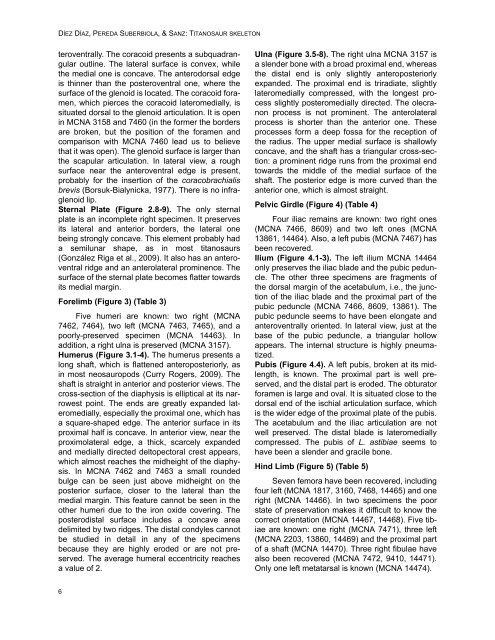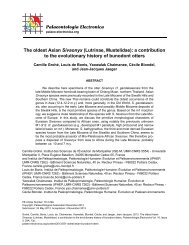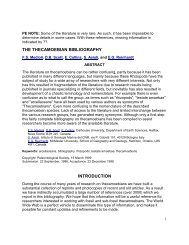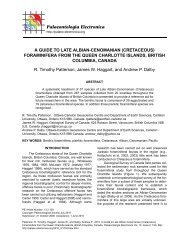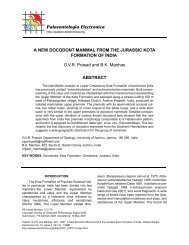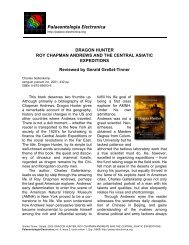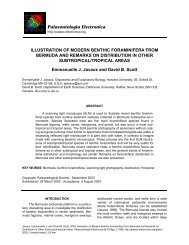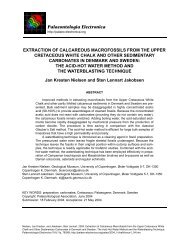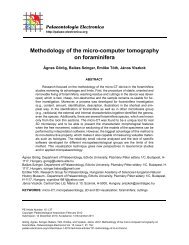Appendicular skeleton and dermal armour of the Late Cretaceous ...
Appendicular skeleton and dermal armour of the Late Cretaceous ...
Appendicular skeleton and dermal armour of the Late Cretaceous ...
You also want an ePaper? Increase the reach of your titles
YUMPU automatically turns print PDFs into web optimized ePapers that Google loves.
DÍEZ DÍAZ, PEREDA SUBERBIOLA, & SANZ: TITANOSAUR SKELETON<br />
teroventrally. The coracoid presents a subquadrangular<br />
outline. The lateral surface is convex, while<br />
<strong>the</strong> medial one is concave. The anterodorsal edge<br />
is thinner than <strong>the</strong> posteroventral one, where <strong>the</strong><br />
surface <strong>of</strong> <strong>the</strong> glenoid is located. The coracoid foramen,<br />
which pierces <strong>the</strong> coracoid lateromedially, is<br />
situated dorsal to <strong>the</strong> glenoid articulation. It is open<br />
in MCNA 3158 <strong>and</strong> 7460 (in <strong>the</strong> former <strong>the</strong> borders<br />
are broken, but <strong>the</strong> position <strong>of</strong> <strong>the</strong> foramen <strong>and</strong><br />
comparison with MCNA 7460 lead us to believe<br />
that it was open). The glenoid surface is larger than<br />
<strong>the</strong> scapular articulation. In lateral view, a rough<br />
surface near <strong>the</strong> anteroventral edge is present,<br />
probably for <strong>the</strong> insertion <strong>of</strong> <strong>the</strong> coracobrachialis<br />
brevis (Borsuk-Bialynicka, 1977). There is no infraglenoid<br />
lip.<br />
Sternal Plate (Figure 2.8-9). The only sternal<br />
plate is an incomplete right specimen. It preserves<br />
its lateral <strong>and</strong> anterior borders, <strong>the</strong> lateral one<br />
being strongly concave. This element probably had<br />
a semilunar shape, as in most titanosaurs<br />
(González Riga et al., 2009). It also has an anteroventral<br />
ridge <strong>and</strong> an anterolateral prominence. The<br />
surface <strong>of</strong> <strong>the</strong> sternal plate becomes flatter towards<br />
its medial margin.<br />
Forelimb (Figure 3) (Table 3)<br />
Five humeri are known: two right (MCNA<br />
7462, 7464), two left (MCNA 7463, 7465), <strong>and</strong> a<br />
poorly-preserved specimen (MCNA 14463). In<br />
addition, a right ulna is preserved (MCNA 3157).<br />
Humerus (Figure 3.1-4). The humerus presents a<br />
long shaft, which is flattened anteroposteriorly, as<br />
in most neosauropods (Curry Rogers, 2009). The<br />
shaft is straight in anterior <strong>and</strong> posterior views. The<br />
cross-section <strong>of</strong> <strong>the</strong> diaphysis is elliptical at its narrowest<br />
point. The ends are greatly exp<strong>and</strong>ed lateromedially,<br />
especially <strong>the</strong> proximal one, which has<br />
a square-shaped edge. The anterior surface in its<br />
proximal half is concave. In anterior view, near <strong>the</strong><br />
proximolateral edge, a thick, scarcely exp<strong>and</strong>ed<br />
<strong>and</strong> medially directed deltopectoral crest appears,<br />
which almost reaches <strong>the</strong> midheight <strong>of</strong> <strong>the</strong> diaphysis.<br />
In MCNA 7462 <strong>and</strong> 7463 a small rounded<br />
bulge can be seen just above midheight on <strong>the</strong><br />
posterior surface, closer to <strong>the</strong> lateral than <strong>the</strong><br />
medial margin. This feature cannot be seen in <strong>the</strong><br />
o<strong>the</strong>r humeri due to <strong>the</strong> iron oxide covering. The<br />
posterodistal surface includes a concave area<br />
delimited by two ridges. The distal condyles cannot<br />
be studied in detail in any <strong>of</strong> <strong>the</strong> specimens<br />
because <strong>the</strong>y are highly eroded or are not preserved.<br />
The average humeral eccentricity reaches<br />
a value <strong>of</strong> 2.<br />
Ulna (Figure 3.5-8). The right ulna MCNA 3157 is<br />
a slender bone with a broad proximal end, whereas<br />
<strong>the</strong> distal end is only slightly anteroposteriorly<br />
exp<strong>and</strong>ed. The proximal end is triradiate, slightly<br />
lateromedially compressed, with <strong>the</strong> longest process<br />
slightly posteromedially directed. The olecranon<br />
process is not prominent. The anterolateral<br />
process is shorter than <strong>the</strong> anterior one. These<br />
processes form a deep fossa for <strong>the</strong> reception <strong>of</strong><br />
<strong>the</strong> radius. The upper medial surface is shallowly<br />
concave, <strong>and</strong> <strong>the</strong> shaft has a triangular cross-section:<br />
a prominent ridge runs from <strong>the</strong> proximal end<br />
towards <strong>the</strong> middle <strong>of</strong> <strong>the</strong> medial surface <strong>of</strong> <strong>the</strong><br />
shaft. The posterior edge is more curved than <strong>the</strong><br />
anterior one, which is almost straight.<br />
Pelvic Girdle (Figure 4) (Table 4)<br />
Four iliac remains are known: two right ones<br />
(MCNA 7466, 8609) <strong>and</strong> two left ones (MCNA<br />
13861, 14464). Also, a left pubis (MCNA 7467) has<br />
been recovered.<br />
Ilium (Figure 4.1-3). The left ilium MCNA 14464<br />
only preserves <strong>the</strong> iliac blade <strong>and</strong> <strong>the</strong> pubic peduncle.<br />
The o<strong>the</strong>r three specimens are fragments <strong>of</strong><br />
<strong>the</strong> dorsal margin <strong>of</strong> <strong>the</strong> acetabulum, i.e., <strong>the</strong> junction<br />
<strong>of</strong> <strong>the</strong> iliac blade <strong>and</strong> <strong>the</strong> proximal part <strong>of</strong> <strong>the</strong><br />
pubic peduncle (MCNA 7466, 8609, 13861). The<br />
pubic peduncle seems to have been elongate <strong>and</strong><br />
anteroventrally oriented. In lateral view, just at <strong>the</strong><br />
base <strong>of</strong> <strong>the</strong> pubic peduncle, a triangular hollow<br />
appears. The internal structure is highly pneumatized.<br />
Pubis (Figure 4.4). A left pubis, broken at its midlength,<br />
is known. The proximal part is well preserved,<br />
<strong>and</strong> <strong>the</strong> distal part is eroded. The obturator<br />
foramen is large <strong>and</strong> oval. It is situated close to <strong>the</strong><br />
dorsal end <strong>of</strong> <strong>the</strong> ischial articulation surface, which<br />
is <strong>the</strong> wider edge <strong>of</strong> <strong>the</strong> proximal plate <strong>of</strong> <strong>the</strong> pubis.<br />
The acetabulum <strong>and</strong> <strong>the</strong> iliac articulation are not<br />
well preserved. The distal blade is lateromedially<br />
compressed. The pubis <strong>of</strong> L. astibiae seems to<br />
have been a slender <strong>and</strong> gracile bone.<br />
Hind Limb (Figure 5) (Table 5)<br />
Seven femora have been recovered, including<br />
four left (MCNA 1817, 3160, 7468, 14465) <strong>and</strong> one<br />
right (MCNA 14466). In two specimens <strong>the</strong> poor<br />
state <strong>of</strong> preservation makes it difficult to know <strong>the</strong><br />
correct orientation (MCNA 14467, 14468). Five tibiae<br />
are known: one right (MCNA 7471), three left<br />
(MCNA 2203, 13860, 14469) <strong>and</strong> <strong>the</strong> proximal part<br />
<strong>of</strong> a shaft (MCNA 14470). Three right fibulae have<br />
also been recovered (MCNA 7472, 9410, 14471).<br />
Only one left metatarsal is known (MCNA 14474).<br />
6


